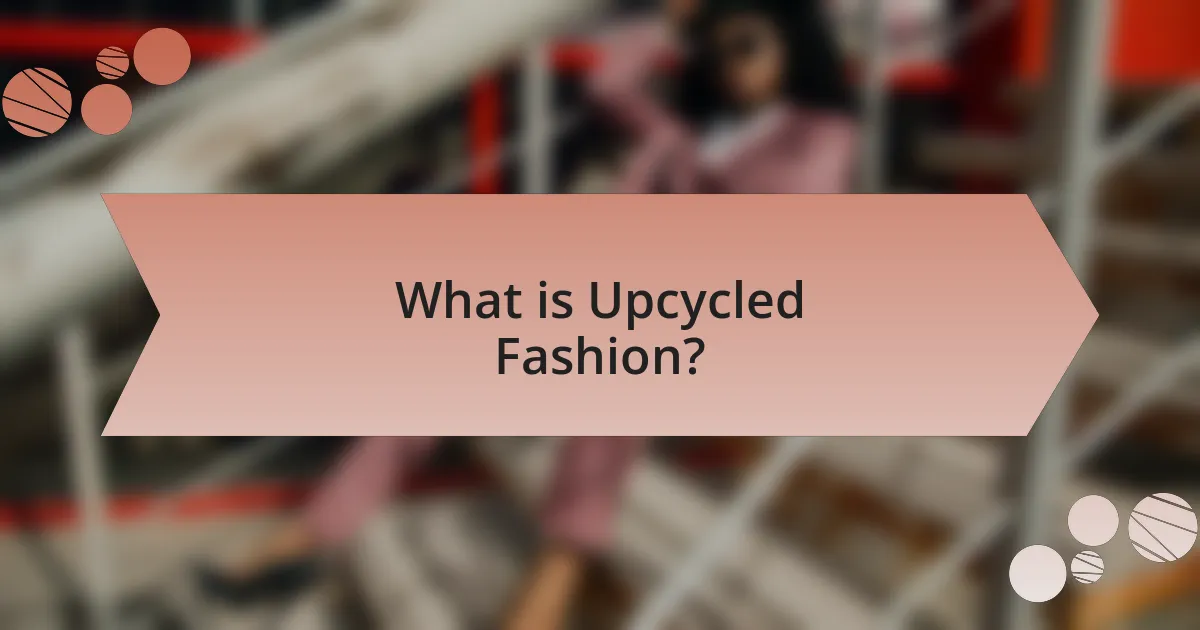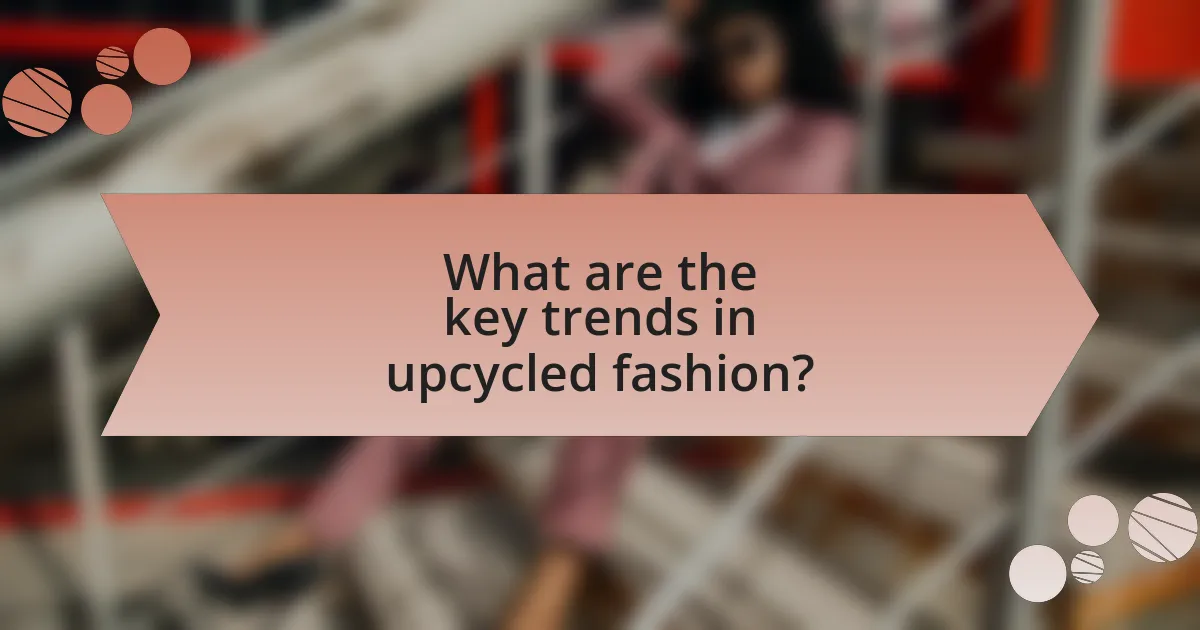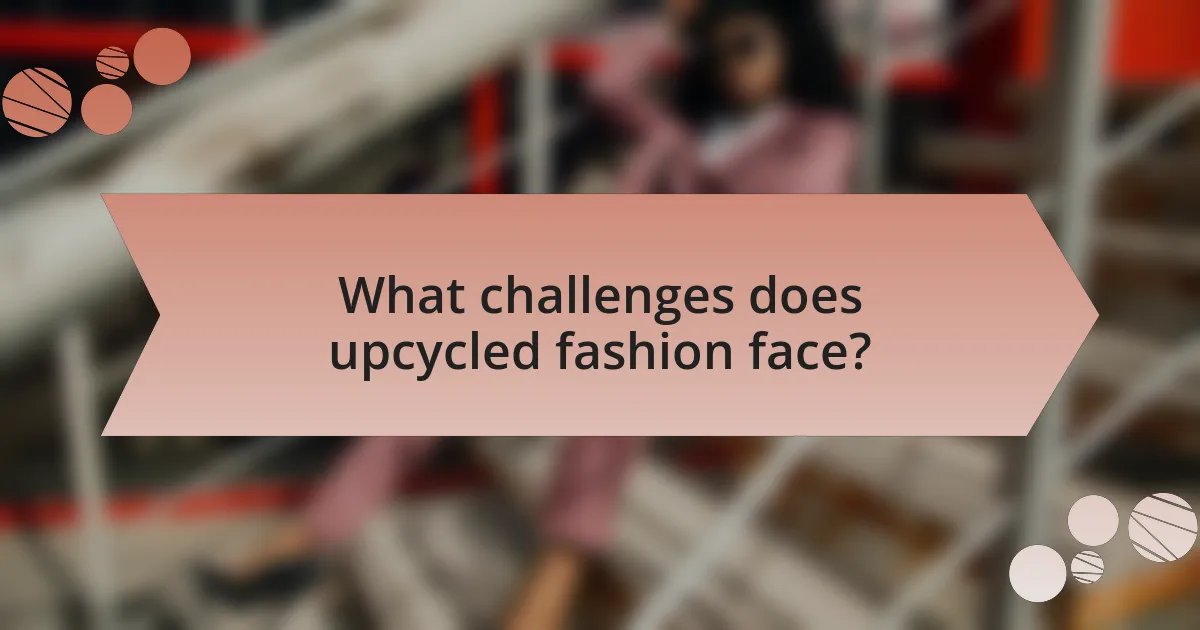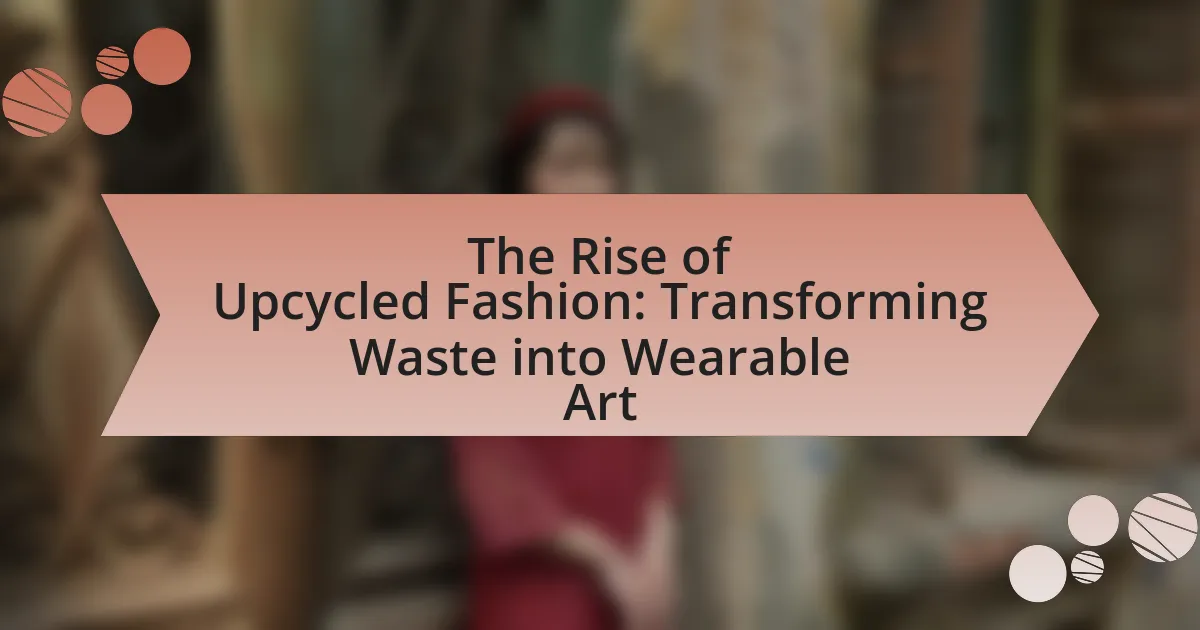Upcycled fashion is the practice of repurposing discarded materials and garments into new clothing and accessories, promoting sustainability and reducing waste in the fashion industry. This article explores the differences between upcycled and traditional fashion, the materials commonly used, and the innovative techniques employed by designers. It highlights the growing popularity of upcycled fashion driven by consumer awareness of environmental issues, the benefits it provides in terms of waste reduction and resource conservation, and the challenges faced in sourcing materials and changing perceptions. Additionally, the article discusses the role of technology and digital platforms in advancing upcycled fashion, as well as practical steps consumers can take to support this sustainable movement.

What is Upcycled Fashion?
Upcycled fashion is the practice of repurposing discarded materials or garments into new clothing or accessories, thereby reducing waste and promoting sustainability. This approach not only minimizes the environmental impact of the fashion industry, which is responsible for significant pollution and resource depletion, but also encourages creativity and individuality in design. According to a report by the Ellen MacArthur Foundation, the fashion industry generates over 92 million tons of waste annually, highlighting the importance of upcycling as a viable solution to combat this issue.
How does upcycled fashion differ from traditional fashion?
Upcycled fashion differs from traditional fashion primarily in its use of pre-existing materials to create new garments, whereas traditional fashion typically relies on new fabrics and resources. Upcycled fashion focuses on sustainability by repurposing discarded items, reducing waste, and minimizing environmental impact, while traditional fashion often contributes to resource depletion and pollution through mass production processes. For instance, a study by the Ellen MacArthur Foundation highlights that the fashion industry is responsible for 10% of global carbon emissions, emphasizing the environmental benefits of upcycling as a more eco-friendly alternative.
What materials are commonly used in upcycled fashion?
Common materials used in upcycled fashion include discarded textiles, vintage clothing, and surplus fabric. These materials are repurposed to create new garments, reducing waste and promoting sustainability. For instance, according to a report by the Ellen MacArthur Foundation, the fashion industry generates over 92 million tons of waste annually, highlighting the importance of utilizing existing materials to mitigate environmental impact. Additionally, upcycled fashion often incorporates materials like denim, leather, and even plastic waste, showcasing creativity while addressing the pressing issue of textile waste.
How is the process of upcycling garments executed?
The process of upcycling garments is executed by creatively transforming discarded clothing into new, functional pieces. This involves several steps: first, selecting garments that are no longer worn or damaged; second, deconstructing these items to salvage usable materials; third, redesigning and reconstructing them into new forms, which may include altering shapes, adding embellishments, or combining multiple pieces; and finally, finishing the new garment with appropriate techniques such as sewing or dyeing. Upcycling not only reduces textile waste but also promotes sustainable fashion practices, as evidenced by the growing number of designers and brands adopting this approach to minimize environmental impact.
Why is upcycled fashion gaining popularity?
Upcycled fashion is gaining popularity due to increasing consumer awareness of environmental issues and the desire for sustainable alternatives to fast fashion. This trend is driven by a growing recognition that the fashion industry is one of the largest polluters globally, with the Ellen MacArthur Foundation reporting that the equivalent of one garbage truck of textiles is landfilled or incinerated every second. Additionally, upcycled fashion offers unique, one-of-a-kind pieces that appeal to consumers seeking individuality in their clothing choices. The combination of environmental consciousness and the quest for personal expression has led to a significant rise in the demand for upcycled garments.
What environmental benefits does upcycled fashion provide?
Upcycled fashion significantly reduces environmental waste by repurposing discarded materials into new garments. This process diverts textiles from landfills, where they would otherwise contribute to pollution and greenhouse gas emissions. According to the Environmental Protection Agency, in 2018, approximately 11.3 million tons of textile waste were generated in the United States alone, highlighting the potential impact of upcycling in mitigating this issue. Additionally, upcycled fashion conserves resources by minimizing the need for new raw materials, thus reducing water and energy consumption associated with traditional garment production. For instance, producing a single cotton t-shirt requires about 2,700 liters of water; upcycling eliminates much of this demand. Overall, upcycled fashion promotes sustainability by addressing waste and resource depletion effectively.
How does upcycled fashion contribute to sustainability in the fashion industry?
Upcycled fashion contributes to sustainability in the fashion industry by reducing waste and minimizing the demand for new resources. This practice involves repurposing discarded materials into new garments, which directly decreases the volume of textile waste sent to landfills. According to the Environmental Protection Agency, in 2018, approximately 11.3 million tons of textile waste were generated in the United States alone, highlighting the significant impact of upcycling in addressing this issue. By utilizing existing materials, upcycled fashion also lessens the environmental footprint associated with the production of new textiles, including water usage and carbon emissions. Thus, upcycled fashion serves as a viable solution for promoting sustainability within the industry.

What are the key trends in upcycled fashion?
Key trends in upcycled fashion include the use of sustainable materials, innovative design techniques, and a focus on individuality. Sustainable materials, such as discarded textiles and vintage clothing, are increasingly being repurposed to create new garments, reducing waste and environmental impact. Innovative design techniques, like patchwork and deconstruction, allow designers to transform old items into unique pieces, emphasizing creativity and craftsmanship. Additionally, the trend towards individuality encourages consumers to seek one-of-a-kind items that reflect personal style, moving away from mass-produced fashion. This shift is supported by a growing consumer awareness of environmental issues and a desire for sustainable practices in the fashion industry.
How are designers incorporating upcycled materials into their collections?
Designers are incorporating upcycled materials into their collections by creatively repurposing discarded textiles, plastic waste, and other materials to create new garments and accessories. This practice not only reduces waste but also promotes sustainability in the fashion industry. For instance, brands like Reformation and Patagonia have successfully integrated upcycled fabrics into their lines, demonstrating that high-quality, fashionable items can be made from previously discarded materials. According to a report by the Ellen MacArthur Foundation, the fashion industry could reduce its environmental impact significantly by adopting upcycling practices, highlighting the importance of this approach in addressing waste and resource depletion.
What innovative techniques are being used in upcycled fashion design?
Innovative techniques in upcycled fashion design include the use of digital printing, laser cutting, and patchwork methods. Digital printing allows designers to create unique patterns on reclaimed fabrics, enhancing their aesthetic appeal while minimizing waste. Laser cutting enables precise alterations and intricate designs on materials that would otherwise be discarded, thus transforming them into high-fashion items. Patchwork techniques combine various fabric scraps into cohesive garments, showcasing creativity and sustainability. These methods not only reduce textile waste but also promote a circular economy in the fashion industry.
Which fashion brands are leading the way in upcycled fashion?
Leading the way in upcycled fashion are brands such as Patagonia, Reformation, and Eileen Fisher. Patagonia has pioneered the use of recycled materials and offers a Worn Wear program that encourages customers to repair and recycle their gear. Reformation focuses on sustainable practices and incorporates upcycled fabrics into their collections, significantly reducing waste. Eileen Fisher has launched a Renew program that takes back worn clothing to be remade into new designs, emphasizing circular fashion. These brands exemplify the commitment to sustainability and innovation in the fashion industry.
What role does consumer awareness play in the rise of upcycled fashion?
Consumer awareness significantly drives the rise of upcycled fashion by increasing demand for sustainable and environmentally friendly clothing options. As consumers become more informed about the negative impacts of fast fashion, such as waste generation and resource depletion, they actively seek alternatives that align with their values. A survey by McKinsey & Company in 2021 revealed that 67% of consumers consider sustainability when making a purchase, highlighting the growing importance of eco-consciousness in consumer behavior. This heightened awareness encourages brands to adopt upcycling practices, thereby transforming waste into fashionable items and contributing to a circular economy.
How are consumers influencing the demand for upcycled products?
Consumers are significantly influencing the demand for upcycled products by prioritizing sustainability and ethical consumption in their purchasing decisions. This shift is evidenced by a growing trend where 54% of consumers express a preference for brands that utilize recycled materials, as reported by a 2021 survey from McKinsey & Company. Additionally, social media platforms amplify awareness and appreciation for upcycled fashion, with influencers showcasing unique pieces that resonate with environmentally conscious consumers. This combination of consumer preference for sustainable practices and the visibility of upcycled products in digital spaces drives increased demand, encouraging brands to innovate and expand their upcycled offerings.
What educational initiatives are promoting upcycled fashion awareness?
Educational initiatives promoting upcycled fashion awareness include programs like the “Fashion Revolution” campaign, which educates consumers about sustainable practices and the impact of fast fashion. Additionally, institutions such as the London College of Fashion offer courses focused on sustainable design and upcycling techniques, equipping students with the skills to innovate in this area. These initiatives are supported by research indicating that educational outreach significantly increases consumer awareness and engagement with sustainable fashion practices, as highlighted in studies conducted by the Ellen MacArthur Foundation.

What challenges does upcycled fashion face?
Upcycled fashion faces several challenges, including limited consumer awareness, inconsistent quality of materials, and scalability issues. Limited consumer awareness hinders market growth, as many potential buyers do not understand the benefits of upcycled products compared to traditional fashion. Inconsistent quality arises from the diverse sources of materials, which can lead to variability in the final product’s durability and appeal. Scalability issues occur because upcycled fashion often relies on small-scale operations that struggle to meet larger market demands, making it difficult to compete with mass-produced clothing. These challenges collectively impact the sustainability and market viability of upcycled fashion.
What are the common misconceptions about upcycled fashion?
Common misconceptions about upcycled fashion include the belief that it is of lower quality than new clothing, that it is only for environmentally conscious consumers, and that it lacks creativity. In reality, upcycled fashion often utilizes high-quality materials and skilled craftsmanship, resulting in unique and durable pieces. Additionally, while many upcycled fashion brands emphasize sustainability, the appeal of these garments extends to a broader audience who appreciate individuality and artistic expression. Furthermore, upcycled fashion can showcase innovative designs and techniques, challenging the notion that it is merely a form of recycling without artistic merit.
How do quality and durability concerns affect consumer perceptions?
Quality and durability concerns significantly influence consumer perceptions by shaping their trust and willingness to purchase products. When consumers perceive a product as high-quality and durable, they are more likely to view it as a worthwhile investment, leading to increased satisfaction and brand loyalty. Conversely, if consumers doubt the quality or durability, they may associate the product with poor performance and short lifespan, which can deter purchases. Research indicates that 62% of consumers consider durability a key factor in their buying decisions, highlighting its importance in shaping perceptions and influencing market trends.
What barriers do designers encounter when sourcing materials for upcycling?
Designers encounter several barriers when sourcing materials for upcycling, including limited availability of suitable materials, inconsistent quality, and logistical challenges. Limited availability arises because upcycled materials often depend on local waste streams, which can be unpredictable and vary by region. Inconsistent quality is a significant issue, as the condition of discarded items can differ greatly, affecting their usability in new designs. Logistical challenges include difficulties in collecting, transporting, and storing materials, which can hinder the efficiency of the upcycling process. These barriers can impede the ability of designers to create innovative and sustainable fashion pieces.
How can the fashion industry overcome these challenges?
The fashion industry can overcome challenges by adopting sustainable practices and embracing upcycling as a core strategy. By integrating upcycled materials into production, brands can reduce waste and lower their environmental impact, as evidenced by the fact that upcycling can divert up to 92 million tons of textile waste from landfills annually. Additionally, educating consumers about the benefits of upcycled fashion can drive demand, leading to increased market viability for sustainable products. Implementing circular economy principles, where materials are reused and recycled, further supports this transition, as demonstrated by companies like Patagonia, which has successfully incorporated recycled materials into their product lines.
What strategies can brands implement to improve the perception of upcycled fashion?
Brands can improve the perception of upcycled fashion by emphasizing transparency in their sourcing and production processes. By openly sharing the origins of materials and the methods used in upcycling, brands can build trust with consumers. For instance, a study by the Ellen MacArthur Foundation highlights that transparency can enhance consumer confidence and willingness to purchase sustainable products. Additionally, brands should engage in storytelling that highlights the unique narratives behind each upcycled piece, showcasing the craftsmanship and creativity involved. This approach not only elevates the perceived value of the products but also connects consumers emotionally to the brand’s mission. Furthermore, collaborating with influencers and sustainability advocates can amplify the message and reach a broader audience, reinforcing the positive perception of upcycled fashion.
How can collaboration between designers and consumers enhance upcycled fashion?
Collaboration between designers and consumers enhances upcycled fashion by fostering innovation and ensuring that products meet consumer preferences. When designers engage with consumers, they gain insights into desired styles, functionality, and sustainability concerns, which can lead to more appealing and marketable upcycled products. For instance, a study by the Ellen MacArthur Foundation highlights that consumer involvement in the design process can significantly increase the perceived value of upcycled items, as consumers feel a sense of ownership and connection to the final product. This collaborative approach not only drives creativity but also promotes a circular economy by encouraging consumers to participate in the upcycling process, ultimately leading to a more sustainable fashion industry.

What is the future of upcycled fashion?
The future of upcycled fashion is poised for significant growth as consumer demand for sustainable practices increases. This trend is driven by a heightened awareness of environmental issues, with a 2021 McKinsey report indicating that 67% of consumers consider sustainability when making a purchase. As brands adopt circular economy principles, upcycled fashion will likely become mainstream, with innovations in materials and design enhancing its appeal. Additionally, collaborations between designers and waste management organizations are expected to expand, further integrating upcycled materials into high-fashion collections.
How is technology shaping the future of upcycled fashion?
Technology is significantly shaping the future of upcycled fashion by enabling innovative design processes and enhancing material recovery methods. Advanced technologies such as 3D printing and digital fabrication allow designers to create unique garments from upcycled materials, reducing waste and promoting sustainability. Additionally, software tools for pattern making and virtual fitting help streamline the design process, making it easier to visualize and produce upcycled clothing. According to a report by McKinsey & Company, the integration of technology in fashion can reduce waste by up to 30%, highlighting its potential impact on the industry.
What role do digital platforms play in promoting upcycled fashion?
Digital platforms play a crucial role in promoting upcycled fashion by providing a marketplace and community for creators and consumers. These platforms, such as social media and e-commerce sites, enable designers to showcase their upcycled products to a global audience, increasing visibility and accessibility. For instance, Instagram has become a vital tool for upcycled fashion brands to share their stories and engage with consumers, leading to a 30% increase in sales for brands that actively use social media for marketing. Additionally, platforms like Etsy facilitate direct sales from creators to consumers, fostering a supportive community that values sustainability and creativity. This digital presence not only enhances brand awareness but also educates consumers about the environmental benefits of upcycled fashion, driving demand and encouraging more sustainable purchasing habits.
How can advancements in recycling technology impact upcycled fashion?
Advancements in recycling technology can significantly enhance upcycled fashion by improving the quality and variety of materials available for designers. Enhanced recycling processes, such as chemical recycling, allow for the breakdown of textiles into their original fibers, enabling the creation of high-quality fabrics from previously discarded garments. For instance, companies like Worn Again Technologies have developed methods to recycle polyester and cotton blends, which were previously challenging to process. This technological progress not only increases the supply of usable materials but also reduces the environmental impact of fashion production, as it minimizes waste and lowers the demand for virgin resources.
What practical steps can consumers take to support upcycled fashion?
Consumers can support upcycled fashion by purchasing items from brands that specialize in upcycling, thereby directly contributing to the reduction of textile waste. By choosing to buy from these brands, consumers help create a market demand for sustainable practices, which encourages more companies to adopt upcycling methods. Additionally, consumers can participate in clothing swaps or upcycling workshops, which promote the reuse of materials and foster community engagement around sustainable fashion. Research indicates that the fashion industry is responsible for 10% of global carbon emissions, highlighting the importance of supporting practices that mitigate environmental impact.
How can individuals incorporate upcycled fashion into their wardrobes?
Individuals can incorporate upcycled fashion into their wardrobes by seeking out clothing and accessories made from repurposed materials or by creatively modifying existing garments. This approach not only promotes sustainability but also allows for unique personal expression. For instance, individuals can shop at thrift stores or online platforms specializing in upcycled items, where they can find one-of-a-kind pieces that have been transformed from discarded materials. Additionally, they can engage in DIY projects, such as turning old jeans into bags or adding embellishments to outdated clothing, which fosters creativity and reduces waste. According to a report by the Ellen MacArthur Foundation, the fashion industry is responsible for significant environmental impact, and upcycling helps mitigate this by extending the lifecycle of textiles.
What are some tips for finding quality upcycled fashion pieces?
To find quality upcycled fashion pieces, prioritize sourcing from reputable brands or designers known for their commitment to sustainability and craftsmanship. Researching brands that specialize in upcycled materials ensures that the pieces are not only stylish but also made with care and attention to detail. Additionally, inspecting the quality of the materials used, such as durable fabrics and well-constructed seams, can help identify high-quality items. Engaging with online communities or local markets dedicated to upcycled fashion can also provide access to unique pieces and insights into the best sources.
